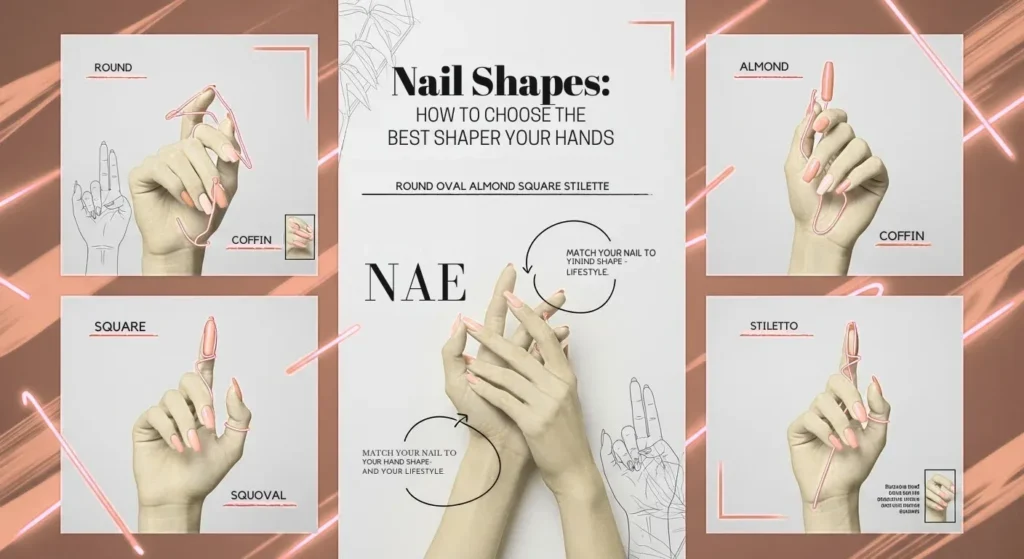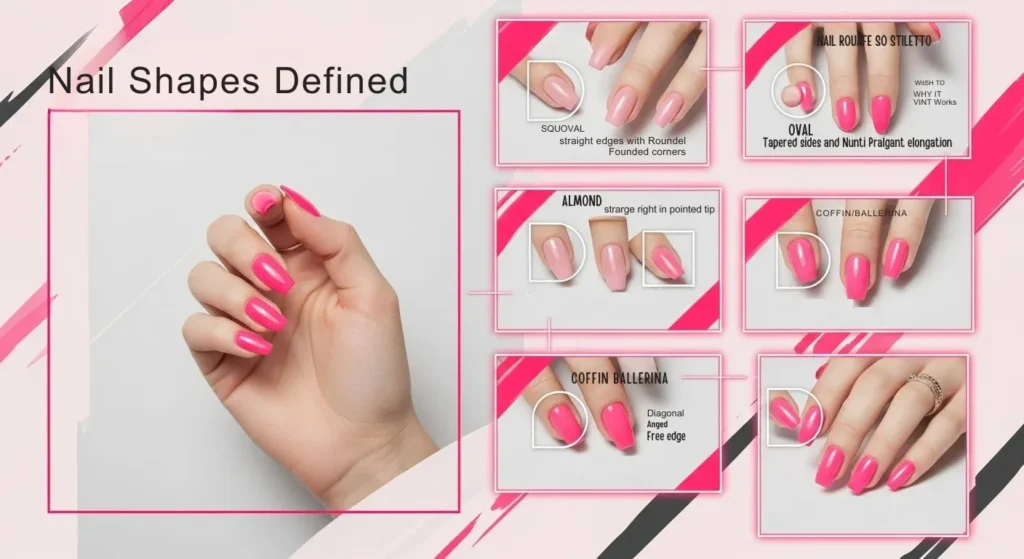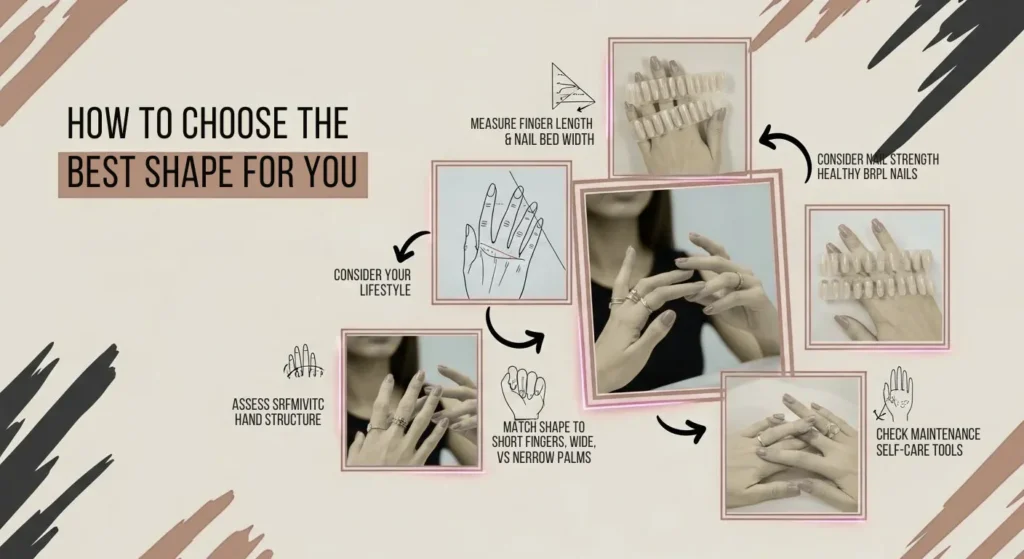
Choosing the best nail shape involves considering finger length, nail bed width, and lifestyle to visually balance and elongate the hands. Options range from practical round and squoval to elegant almond or oval and dramatic coffin or stiletto. The most flattering and practical style aligns with natural nail structure and daily needs.
Ever found yourself staring at your fingertips and thinking: “What nail shape is actually me” You’re not alone. Choosing a nail shape isn’t just about “what looks pretty” (though of course that helps). It’s about what works with the shape of your hands, your lifestyle, your nail strength and yes, your mood.
Here’s a simple table summarising which shapes tend to suit which hand/finger/bed types. Use it as a quick guide and then I’ll walk through each factor in detail.
| Hand / Finger / Nail Bed Type | Nail Shapes That Flatter | Key Reason |
| Short fingers / wide nail beds | Round, Squoval, Oval | Soft curves help elongate fingers |
| Long fingers / narrow nail beds | Square, Coffin/Ballerina, Almond | Straight sides or taper add structure |
| Wide palms / short fingers | Almond, Oval | Tapered sides help balance width |
| Narrow palms / long fingers | Square, Stiletto | Strong structural lines, elongating effect |
| Weak or brittle nails | Round, Squoval | Softer edges, less prone to snagging |
How to Evaluate Your Hands Before Choosing a Shape
Finger Length vs Fingertip:
Look at your fingers from the base (where they meet your palm) to the tip. Are they visually short, average, long? Short fingers tend to look stubby with blunt nail shapes; long fingers can carry sharper, dramatic shapes better.
Nail Bed Width:
“Nail bed” = the area of nail from side wall to side wall (not the free edge). If your nail beds are wide (you can see a lot of nail when you look at the finger straight on), then very narrow pointed nail shapes might look off-balance; conversely, narrow beds with wide shapes can look too wide.
Palm / Finger Ratio:
If your palm is wide compared to your fingers (or your finger base is quite broad) a shape that tapers (like almond) can help elongate and balance. If your fingers are slender and your palm narrow, shapes with stronger edges (square) can look chic.
Nail Strength & Natural Length:
If your nails are naturally strong and long, you have more freedom to experiment with dramatic shapes (stiletto, coffin). If your nails are weak or you prefer shorter lengths for practical reasons, choose shapes that are durable and low-maintenance (round, squoval).
Lifestyle & Practicality:
If you type a lot, cook, do gym, hand-work or child-care, you might want shorter nails and softer edges to avoid breakage, snagging or discomfort. A dramatic long stiletto looks lovely but might not be realistic.
Nail Shapes Defined

Let’s go through the common shapes, what they look like, when they work, and practical notes. I’ll throw in a few less-common ones too.
Round:
Shape: Follows the natural curve of the fingertip; the free edge is softly rounded rather than squared.
When to pick: Short fingers, wide nail beds, you want a simple everyday look. According to Real Simple: “softens and slims wide nail beds and helps shorter fingers look elongated. Very durable, minimal maintenance. Great if you prefer a lower-key or practical mani.
Squoval (Square + Oval):
Shape: Straight across free edges like square, but corners rounded.
When to pick: A safe “universal” shape when you’re unsure; works on many hand types. Real Simple: easiest shape to maintain.
Practical notes: Great compromise between style + durability.
Oval:
Shape: Sides slightly tapered in, tip rounded rather than sharp.
When to pick: Shorter fingers or wider nail beds, where you want elongation but not dramatic taper. OPI: oval elongates nails in both width and length.
Almond:
Shape: Tapered sides, tip comes to a soft peak (less sharp than stiletto).
When to pick: Want elongation, fingers average-to-long, nail bed moderate. Real Simple: “lengthen and make short fingers look slim.”
Square:
Shape: Straight sides, flat free edge, corners may be sharp.
When to pick: Long fingers with narrow beds; you like bold geometry. Real Simple: “long fingers with narrow nail beds” work well.
Coffin / Ballerina:
Shape: Long sides taper slightly, squared tip (looks like a coffin or ballet slipper).
When to pick: Strong, long nails; fingers long and slender; you want dramatic style. OPI: “long, slim, and squared-off tip suits long, slender fingers.”
Stiletto:
Shape: Very tapered sides, tip ends in a sharp point.
When to pick: Nails are long and strong or acrylic/gel enhancements; you want a fashion forward look. Real Simple: “toughest to maintain, most susceptible to breakage.”
Lipstick Shape:
Shape: Diagonal slant on free edge so nail looks like the angled tip of a lipstick.
When to pick: Want trend-y, unique; length is moderate; you’re comfortable with something non-traditional. OPI mentions this as “The Influencer” shape.
Flare / Arrowhead / Other Trend Shapes:
There are less-common shapes like flare (wider at tip), arrowhead, etc. Some guides mention these extras.
When to pick: You’re comfortable with nails as style statements and willing to maintain.
Practical notes: More niche, more likely to snag or require acrylic/enhancement.
How to Choose the Best Shape for You

Now the fun part: combining all the criteria into a decision-making process.
Measure your finger length & nail bed width:
- Look at your pinky finger: is the nail bed fairly wide (you see lots of nail) or narrow (thin)
- Look at your index or middle finger length vs palm. Are they short/average/long?
- Use the cheat-table above as a starting point.
Consider your lifestyle & daily activities:
- Do you type a lot or work with your hands, Choose shapes with fewer corners and less height (round, squoval) to avoid breakage.
- Do you prefer long nails or do you keep them short for practicality? If short, skip very long statement shapes.
- Do you enjoy nail art or wild shapes? That opens up more options (almond, lipstick, coffin) but factor in maintenance.
Assess nail strength & length:
- If your natural nails break easily, go for simpler shapes with no extreme point or elongated tip.
If you have strong nails (or use gel/acrylic) you can experiment with longer, sharper shapes. - Keep future growth in mind: if you’re growing nails out, pick shapes that transition well.
Match shape to your hand structure:
- Wide nail beds + shorter fingers → go for tapering shapes (oval, almond) to elongate and slim.
- Narrow nail beds + long fingers → you can carry stronger edges (square, coffin).
- Palms wide relative to fingers → tapered shapes help balance.
- Palms narrow and fingers long → shapes with width at the tip (square, maybe short coffin) might look good.
Maintenance check:
- Longer or sharper shapes = more upkeep (you’ll need more frequent filing, possibly strengthening treatments).
- More natural/shaped shapes = less maintenance.
- Ask yourself: “Am I okay going to the salon or doing at-home maintenance every 2-3 weeks, or do I want something low-effort”
My Top 5 Practical Tips That Most Guides Miss
- Look at your cuticle line: If your cuticle is very curved or you have a “wide” base of the nail bed, a shape with tapering sides helps visually elongate the nail area. Not many guides emphasise this.
- Short nails ≠ fewer options: Even if your nails are short by choice or due to breakage, you can still pick great shapes (oval, squoval) that elongate without going long. The “short nails are limited” idea is oversold.
- Color & shape interplay: If you choose a dramatic shape (e.g., almond) but use a subtle color, the effect is more balanced. Conversely, a bold color on a dramatic shape multiplies the “look” (which may or may not be what you want).
- Growth & transition planning: If you’re growing your nails or changing shapes (say from square to almond), pick an intermediate shape (squoval → oval → almond) to ease the transition and avoid needing extreme filing.
- Protect your shape with care: Once you have your shape, you need to protect it. Daily cuticle oil, using gloves for chores, avoiding using nails as “tools” will preserve it. Many guides mention file direction, but fewer talk about protection post-shape.
FAQs
What shape makes fingers look longer?
Shapes that elongate fingers typically narrow at the sides and/or come to a soft tip for example, almond, oval. These shapes create a visual “length” to the nail bed. (See competitor Real Simple and others).
I have weak/brittle nails. Which shape should I avoid?
Avoid shapes with sharp corners or overly long tips (like stiletto, long square) because corners and points can catch and break. Softer shapes like round or squoval are more durable.
Can I switch nail shapes between salon visits?
Absolutely. You can transition from one shape to another, but make sure your nails are healthy, and be prepared for a short adjustment period. Going from a bold shape (like coffin) back to a simpler shape (round) is often easier than vice-versa if your nails grow stronger.
Does nail length matter more than shape?
Yes and no. Length is a factor. A long almond will look different from a short almond. But shape still matters even at shorter lengths. For example, a squoval short nail looks different (and better for some hands) than a blunt square short nail. So, choose shape and length together.
I type a lot / work a lot with my hands. Which shapes should I pick?
Go for practical shapes: round, squoval, maybe short ovals. Avoid long pointy shapes or anything that has a very narrow tip which can snag. Also consider shorter lengths and keep edges smooth.
How often do I need to maintain the shape?
It depends on how fast your nails grow and how perfect you want the shape. Generally, every 2–3 weeks is common for salon sets; at home you might check every week and file lightly to maintain. Shapes with more dramatic sides/tips may require more frequent upkeep.
Final Thoughts
Choosing the best nail shape for your hands isn’t just about copying the “it-shape” of the moment (though trends matter). It’s about your hand structure, your nail health, your lifestyle, your comfort and your style. By combining what you’ve learned (finger & nail bed shape, lifestyle, maintenance, nail strength) with the cheat-table and the shape breakdown above, you’ll be in a much stronger position to pick a shape that looks amazing and works for your everyday life.
